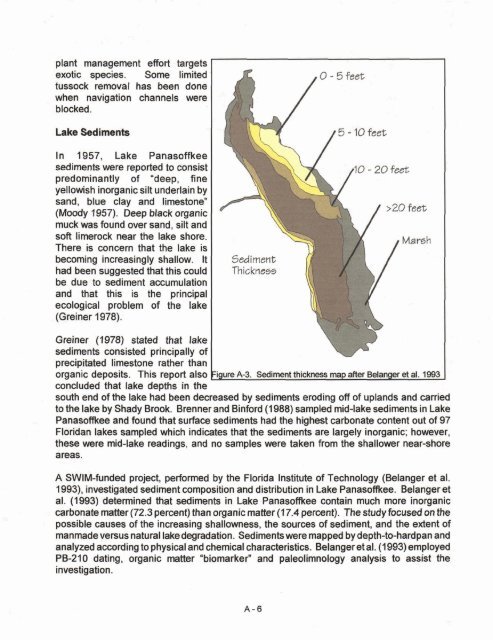Lake Panasoffkee SWIM Plan - Southwest Florida Water ...
Lake Panasoffkee SWIM Plan - Southwest Florida Water ...
Lake Panasoffkee SWIM Plan - Southwest Florida Water ...
You also want an ePaper? Increase the reach of your titles
YUMPU automatically turns print PDFs into web optimized ePapers that Google loves.
plant management effort targets<br />
exotic species. Some limited<br />
tussock removal has been done<br />
when navigation channels were<br />
blocked.<br />
<strong>Lake</strong> Sediments<br />
In 1957, <strong>Lake</strong> <strong>Panasoffkee</strong><br />
sediments were reported to consist<br />
predominantly of "deep, fine<br />
yellowish inorganic silt underlain by<br />
sand, blue clay and limestone*<br />
(Moody 1957). Deep black organic<br />
muck was found over sand. silt and<br />
soft limerock near the lake shore.<br />
There is concern that the lake is<br />
becoming increasingly shallow. It<br />
had been suggested that this could<br />
be due to sediment accumulation<br />
and that this is the principal<br />
ecological problem of the lake<br />
(Greiner 1978).<br />
.<br />
Sediment<br />
Thickness<br />
/<br />
5 - 10 feet<br />
00 - 20 feet.<br />
Greiner (1978) stated that lake<br />
sediments consisted principally of<br />
precipitated limestone rather than<br />
organic deposits. This report also igure A-3. Sediment thickness map after Belanger et al. 1993<br />
concluded that lake depths in the<br />
south end of the lake had been decreased by sediments eroding off of uplands and carried<br />
to the lake by Shady Brook. Brenner and Binford (1988) sampled mid-lake sediments in <strong>Lake</strong><br />
- <strong>Panasoffkee</strong> and found that surface sediments had the highest carbonate content out of 97<br />
<strong>Florida</strong>n lakes sampled which indicates that the sediments are largely inorganic; however,<br />
these were mid-lake readings, and no samples were taken from the shallower near-shore<br />
areas.<br />
A <strong>SWIM</strong>-funded project, performed by the <strong>Florida</strong> Institute of Technology (Belanger et al.<br />
1993). investigated sediment composition and distribution in <strong>Lake</strong> <strong>Panasoffkee</strong>. Belanger et<br />
al. (1993) determined that sediments in <strong>Lake</strong> <strong>Panasoffkee</strong> contain much more inomanic<br />
carbonate matter (72.3 percent) than organic matter (17.4 percent). he study focused on the<br />
~0Ssible causes of the increasina shallowness. the sources of sediment. and the extent of<br />
knmade versus natural lakedegradation. ~edihents were mapped by depth-to-hardpan and<br />
analyzed according to physical and chemical characteristics. Belangeret al. (1993) employed<br />
PB-210 dating, organic matter "biomarker" and paleolimnology analysis to assist the<br />
investigation.
















